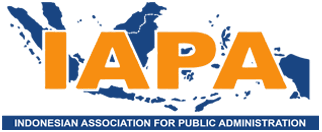Design of Village, Community and Private Government Partnership Model in Labor: Study in Gempol Subdistrict, Pasuruan Regency
DOI:
https://doi.org/10.21776/ub.jpas.2019.004.01.1Keywords:
Partnership, employment, service qualityAbstract
This research is focused on the implementation of partnerships which includes the legal basis of implementation, the role of each party, form and model of partnership. In fact, the employment partnership of the village government, the private sector and the community lasts quite a long time, but it has not been able to improve the quality of employment services. The results of the study show that employment partnerships are carried out by two parties, namely the village-private and public-private governments, which are based on the outcome of the agreement through an agreement, in the implementation there is no equality of position between the partners, the coordination relationship is low and there is no balance of benefits and risks. While the partnership form is similar to the build own operate, the partnership model is franchise and free market.References
Ananta, A. (1990) Modal Manusia dan Pembangunan Ekonomi Dalam Ekonomi Sumber Daya Manusia, lembaga Demografi FEUI, Jakarta.
Anton, A. (2008) Not for Sale: In Defense of Public Goods, Westview Press Oxford.
Bappenas, (2002) Public Good Governance: Sebuah Paparan Singkat, Jakarta: Sekretariat Pengembangan Public Good Governance Bappenas.
Broadbent, J. & Guthrie, J. (1992) Changes in the Public Sector: A Review of Recent Alternative Accounting Research. Accounting, Auditing & Accountability Journal, 5.
Denhartd, J.V & Denhartd, R.B. (2003) The New Public Service: Serving not Steering, M.E. Sharpe, Inc, New York.
Dwiyanto, A. (2011) Manajemen Pelayanan Publik: Peduli, Inklusif, dan Kolaboratif. Edisi Kedua. Gajah Mada University Prees. Yogyakarta.
Dwiyanto, A.(2006) Reformasi Birokrasi Publik di Indonesia, Gadjah Mada University Press, Yogyakarta.
Ebrahimi, M. S. & Golabi, S. (2013) Analysis of industrial Areas
Effects in Rural Development A Case Study of Iran, Journal of Rural and Industrial Development, 1(2).
Ghare, K. R. (2001) Probing The Strategic Intricacies of Public-Private Partnership: The patent as A Comparative Reference, Public Administration Review, 61 (1), 441-251.
Gnyawali, R. (2001) Cooperative Networks and Competitive Dynamic: A Structural Embeddedness Perspectives, Academy of Management Review, 20(3), 431-445.
Grimsey, D. & Lewis, M.K. (2004) Public Private Partnerships: The Worldwide Revolution in Infrastructure Provision and Project Finance, Edward Elgar Publishing Limited Cheltenham, UK-Northampton, MA, USA.
Hatu, R. (2011) Perubahan Sosial Kultural Masyarakat Pedesaan, Jurnal Inovasi, 8(4), 1-11.
Hood, C.A. (1991) Public Management for All Seasons, Public Administration Review, 7(12), 1-10.
Howlett, M & M. Ramesh. (1995) Studying Public Policy: Policy Cycles and Policy Subsystem, Oxford University Press, New York
Kausik, R. (2015) Rural entrepreneurship and development of rural areas, International Journal of Commerce and Management Research, 1(2),69-71.
Klijn, H.E. (2001) RulesInstitutional Context for Decision Making in Networks: The Approach to Postwar Housing District in Two Cities, Administration and Society, 33(2),133-164.
Koiman, J. (1994) Modern Governance: New Government-Society Interactions. London: SAGE Publications.
Kyei, R.O & Chan, P.C. (2016) Implementing Public-Private Partnership (PPP) Policy for Public Construction Projects in Ghana: Critical Success Factors and Policy Implications, International Journal of Construction Management, 1(1),1-10.
Mahmudi, (2005) Manajemen Kinerja Sektor Publik. VPP, AMP, YKPN, Yogyakarta
Miles, M.B. Hubberman, A.M. Saldana, Johny. (2014)Qualitative Data Analysis: A Methods Souebook (3rd Edition),Sage Publications, Arizona State University.
Nasution, M.N. (2004) Manajemen Mutu Terpadu, Ghalia Indonesia, Jakarta.
Ndraha, T. 2003. Kybernology (Ilmu Pemerintahan Baru). Jakarta: PT. Rineka Cipta.
Nuwagaba, A. (2012) Toward Addressing Skills Development and Employment Crisis in Uganda: The Role of Public-Private Partnerships,Uganda: Makerere University.
Oliveira, C, Carlos, M, & Rui, C. (2013) Infrastructure Public-Private Partnerships: Decision, Management and Development, Springer, Heidelberg New York Dordrecht London
Osborne, D. & Geabler, T. (1992) Reinventing Government: How The Entrepreneurial Spirit is Transforming The Public Service,New York
Parker, A. (1992) Sosiologi Industri,PT. Rineka Cipta, Jakarta.
Peraturan Daerah Kabupaten Pasuruan Nomor 2 Tahun 2010 tentang Kerjasama.
Peraturan Daerah Kabupaten Pasuruan Nomor 22 Tahun 2012 tentang Sistem Penyelenggaraan Ketenagakerjaan di Kabupaten Pasuruan.
Peraturan Menteri Dalam Negeri Nomor 38 Tahun 2007 tentang Kerjasama Desa.
Pongsin, Nutavoot (2002) Regulation and Public-Private Partnership, International Journal of Public Sector management, 15(6), 487-495.
Rhodes, R.A.W. (1996) The New Governance: Governing Without Government, Political Studies, XLIV: 652-667.
Robinson, H, Carillo, P.A, Chimay, J. P (2010) Governance & Knowledge Management for Public-Private Partnerships, John Wiley & Sons Ltd, Publication, United Kingdom.
Rosen, H. S. (1988) Public Finance, Illionis: Richard D. Irwin, Inc. Inggris.
Sapte, D.W. (2006) Public Private Partnerships: BOT techniques and project finance, 2nd Edition, Euromoney Books, London.
Savas, E S. (1987) Privatization: The Key to Better Government, Chatham: Catham House Publishers, Inc.
Savas, E.S. (2000) Privatization and Public Private Partnership, Chatham House Publisher, Inc, New Jersey.
Simanjuntak, P.J. (1985) Pengantar Ekonomi Sumber Daya Manusia, BPFEUI, Jakarta
Sinabela, L.P. (2006) Reformasi Pelayanan Publik, Bumi Aksara, Jakarta.
Stoker, G. (1998) Governance as Theory: Five Propositions, International Social Science Journal, 155(1),17-28.
Syaifullah (2009) Industrialisasi, Manusia Industri dan Perubahan Sosial, Jurnal Geografi GEA, 9 (1), 39-50.
Undang-undang Republik Indonesia Nomor 13 Tahun 2003 tentang Ketenagakerjaan.
Undang-undang Republik Indonesia Nomor 6 Tahun 2014 tentang Desa.
UNDP(1998) Participatory Local Governance, Technical advisory Paper I. Local Initiative Facility for Urban Environment (LIFE). New York.
Urio, P. (2010) Public-Private Partnerships; Success and Failure Factors for In-Transition Countries, University Press Of America, IncYork University Lanham, Boulder, New York, Toronto, Plymouth, UK.
Downloads
Published
Issue
Section
License
Copyright Statement
Authors who publish with JPAS agree to the following terms:
(1). Authors retain copyright and grant the journal right of first publication with the work simultaneously licensed under a Creative Commons Attribution License that allows others to share the work with an acknowledgement of the work's authorship and initial publication in this journal.
(2). Authors are able to enter into separate, additional contractual arrangements for the non-exclusive distribution of the journal's published version of the work (e.g., post it to an institutional repository or publish it in a book), with an acknowledgement of its initial publication in this journal.
(3). Authors are permitted and encouraged to post their work online (e.g., in institutional repositories or on their website) prior to and during the submission process, as it can lead to productive exchanges, as well as earlier and greater citation of published work (See The Effect of Open Access).
Permissions and reuse
For authors
Authors may use their own articles for the following non-commercial purposes without asking our permission (and subject only to acknowledging first publication in JPAS and giving a full reference or web link, as appropriate).
(1). Posting a pdf of their own article on their own personal or institutional website, for which no charge for access is made.
(2). Making a reasonable number of copies for personal or non commercial professional use.
This includes the contributors own teaching purposes.
(1). Republishing part or all of the article in a book or other publication edited by the author (except for multiple contributions in the same book or publication, for which permission needs to be sought.
(2). Using individual figures or tables or extracts of text (up to 300 words) in other publications published by a third party.
(3). Using the article in a course pack or compilation (whether paper or electronic) in the authors institution. This does not apply if a commercial charge is made for the compilation or training programme.
For third parties
All articles published by JPAS are published by default as open access.















